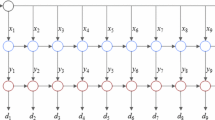Abstract
We show that the production-transportation problem involving an arbitrary fixed number of factories with concave production cost is solvable in strongly polynomial time. The algorithm is based on a parametric approach which takes full advantage of the specific structure of the problem: monotonicity of the objective function along certain directions, small proportion of nonlinear variables and combinatorial properties implied by transportation constraints.
Similar content being viewed by others
References
M.L. Balinski, “The Hirsch conjecture for dual transportation polyhedra,” Collaborative paper, bf CP-83-9, IIASA, Laxenburg, Austria (1983).
M.S. Bazaraa and J.J. Jarvis,Linear Programming and Network Flows (Wiley, New York, 1977).
P.C. Chen and P. Hansen, “On-line and off-line vertex enumeration by adjacency lists,”Operations Research Letters 10 (1991) 403–409.
M.A. Efroymson and T.R. Ray, “A branch and bound algorithm for plant location,”Operations Research 14 (1966) 361–368.
E. Feldman, F.A. Lehrer and T.L. Ray, “Warehouse location under continuous economies of scale,”Management Science 12 (1966) 670–684.
M. Florian and M. Klein, “Deterministic production planning with concave costs and capacity constraints”,Management Science 18 (1971) 12–20.
G.M. Guisewite and P.M. Pardalos, “A polynomial time solvable concave network flow problem,”Networks 23 (1990) 143–147.
G.M. Guisewite and P.M. Pardalos, “Minimum concave cost network flow problems: applications, complexity and algorithms,”Annals of Operations Research 25 (1990) 75–100.
S.L. Hakimi and C.C. Kuo, “On a general network location-production-allocation problem,”European Journal of Operations Research 55 (1991) 31–45.
D.S. Hochbaum and J.G. Shantikumar, “Convex separable optimization is not much harder than linear optimization,”Journal of the Association for Computing Machinery 37 (1990) 343–362.
R. Horst and H. Tuy,Global Optimization (Springer, Berlin, 1990).
B.M. Khumawala and D.L. Kelly, “Warehouse location with concave costs,”INFOR 12 (1974) 55–65.
B. Klinz and H. Tuy, “Minimum concave cost network flow problems with a single nonlinear arc cost,” P.M. Pardalos and D.-Z. DuNetwork Optimization Problems, (World Scientific, Singapore, 1992) pp. 125–143.
H. Konno “Minimum concave cost production system: a further generalization of multiechelon model,”Mathematical Programming 41 (1988) 185–193.
P. Krarup and P.M. Pruzan, “The simple plant location problem: survey and synthesis,”European Journal of Operations Research 12 (1983) 36–81.
H.W. Lenstra Jr., “Integer programming with a fixed number of variables,”Mathematics of Operations Research 8 (1983) 538–548.
L. Lovász and H.E. Scarf, “The generalized basis reduction algorithm,”Mathematics of Operations Research 17 (1992) 751–764.
T.L. Magnanti and R.T. Wong, “Network design and transportation planning: models and algorithms,”Transportation Science 18 (1984) 1–55.
A.S. Nemirowsky and D.D. Yudin,Problem Complexity and Method Efficiency in Optimization (Wiley, New York, 1983).
P.M. Pardalos and S.A. Vavasis, “Quadratic programming with one negative eigenvalue is NP-hard,”Journal of Global optimization 1 (1991) 15–22.
P.M. Pardalos and S.A. Vavasis, “Open questions in complexity theory for nonlinear optimization,”Mathematical Programming 57 (1992) 337–339.
J.F. Shapiro,Mathematical Programming Structures and Algorithms (Wiley, New York, 1979).
R.M. Soland, “Optimal facility location with concave costs,”Operations Research 22 (1974) 373–382.
E. Tardos, “A strongly polynomial minimum cost circulation algorithm,”Combinatorica 5 (1985) 247–255.
T.V. Thieu, “Solving the lay-out planning problem with concave cost”, in:Essays in Nonlinear Analysis and Optimization (Institute of Mathematics, Hanoi, 1987) pp. 101–110.
H. Tuy, “Concave minimization under linear constraints with special structure,”Optimization 16 (1985) 335–352.
H. Tuy, N.D. Dan and S. Ghannadan, “Strongly polynomial algorithms for certain concave minimization problems on networks,”Operations Research Letters, 14 (1993) 99–109.
H. Tuy, S. Ghannadan, A. Migdalas and P. Värbrand, “Strongly polynomial algorithm for a production-transportation problem with concave production costs,”Optimization 27 (1992) 205–228.
H. Tuy, S. Ghannadan, A. Migdalas and P. Värbrand, “Minimum concave cost network flow problems with a fixed number of nonlinear arc costs and sources,”Journal of Global Optimization 6 (1992) 135–151.
H. Tuy, S. Ghannadan, A. Migdalas and P. Värbrand, “Strongly polynomial algorithm for two special minimum concave cost network flow problems,”Optimization 32 (1995) 23–43.
H. Tuy and B.T. Tam, “An efficient solution method for rank two quasi-concave minimization problems,”Optimization 24 (1992) 43–56.
H.M. Wagner and T.M. Whitin, “Dynamic version of the economic lot size model,”Management Science 5 (1959) 89–96.
S.W. Wallace, “Decomposition of the requirement space of a transportation problem into polyhedral cones,”Mathematical Programming Study 28 (1986) 29–47.
W.I. Zangwill, “A Backlogging Model and a multi-echelon model of a dynamic economic lot size production system—a network approach,”Management Science 15 (1969) 509–527.
Author information
Authors and Affiliations
Rights and permissions
About this article
Cite this article
Tuy, H., Ghannadan, S., Migdalas, A. et al. A strongly polynomial algorithm for a concave production-transportation problem with a fixed number of nonlinear variables. Mathematical Programming 72, 229–258 (1996). https://doi.org/10.1007/BF02592091
Received:
Revised:
Issue Date:
DOI: https://doi.org/10.1007/BF02592091



